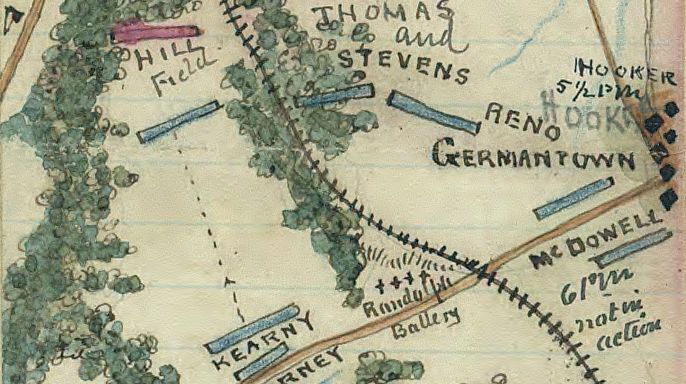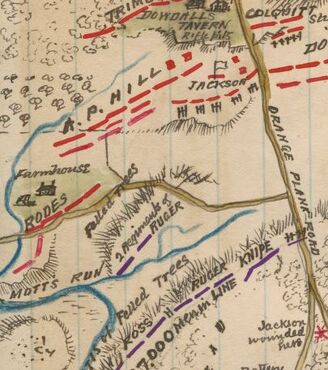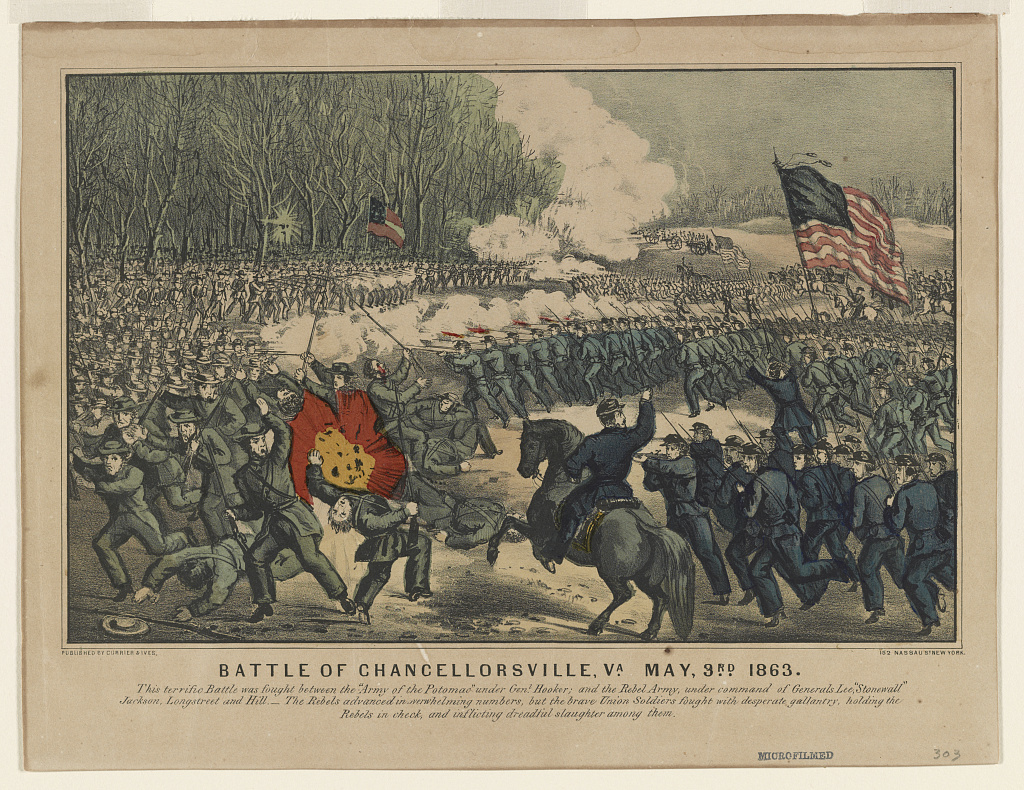In the summer of 1862, a company made up of residents from Ashe County had just faced off against a Union force at the Battle of Gaine’s Mill. After the stalemate of that battle, the Union army retreated, and the Confederate pursuit of the retreating Union lines continued. Three days later, on June 28th, 1862, Company A was once again lined up for attack. The battle of Frayser’s Farm (sometimes referred to as the Battle of Glendale) was a fairly minor battle in the great scope of the war, but it was a horrific day for Company A. Believing in the outsized abilities of the Confederate soldiers, General Lee committed to attack an enemy position twice the size of the southern forces. Company A found themselves in the heaviest fighting. They were mercilessly bombarded by a Union artillery position attacking with canister rounds, which mauled infantry lines by shooting dozens of one inch iron balls simultaneously. The battery position was eventually overtaken and the Union forces driven from the field, but not without great cost to Company A. In the course of the attack, John Holdaway, a 34 year old farmer from Alleghany County was killed. James Woodie, who fought alongside his two older brothers, was also killed on the field. Jesse Sheets, the 35 year old 3rd Sergeant, was wounded in the battle and taken to the hospital in Richmond – he would die there two weeks later. William Perry was shot through the knee and also sent to the Richmond hospital. He would die there from disease on July 16th. Wilborn H. Long also died, although of an unknown cause. Whether his death was in combat or from wounds suffered in the battle is unclear.
These fights, which made up the larger campaign known as the Seven Days Battles, were over, and Company A moved to camp south of Richmond, where they spent the rest of July. Here the company’s most menacing enemy – disease – once again attacked. Troy Miller, the company’s bugler, contracted typhoid and was discharged from military service. This dismal time in camp also began to test the resolve of company members, who had now been away from Ashe and Alleghany counties for almost a year. John Petty, who had suffered a terrible skin infection while the company was camped at Camp Mangum in Ralegh, deserted by the end of the month. Calvin Shoemaker, who had three fingers shot off his hand at Gaine’s Mill, also took the opportunity to abandon the army. Linville Price, whose cousins had recently been lynched in Jefferson as Union sympathizers, turned hard against the war effort. He deserted the army by the end of July and returned to Whitetop, Virginia. Although he would briefly be conscripted back into the army, he would become an active member of the Heroes of America, also known as the Red Strings; a group that secretly worked to undermine the war effort by spying on Confederate movements and assisted Union war prisoners in escaping Southern prisons. Price would end the war in a Confederate prison for his involvement with this group.
Although engaged briefly at Cedar Run, Company A experienced little excitement during the majority of August. Stephen Wilson, the 45 year old Alleghany farmer who had first been elected captain of the company, resigned on August 4th, complaining about his poor health. As the senior captain of the regiment, Wilson also felt that his resignation would allow more able officers to rise to the rank of major. He would serve out the rest of the war as a captain in the 5th North Carolina Senior reserves. Washington Osborne, a 27 year old private, was taken ill and died of disease in August. Harden Sullivan also died of an unknown cause. At this same time, four more enlistees decided to abandon the war effort and deserted the army all together. John F. Shepherd, who had been one of the oldest enlistees the year before, deserted in July. Others were George Baker, William Martin Viers, Ephraim Osborne, and Allen M. Richardon, who had been the first member of the company wounded in battle and whose brother had, six months earlier, died from disease in Goldsboro.
The rest of Company A was soon mobilized in Stonewall Jackson’s attack on Manassas Junction. As part of Jackson’s force, Company A was forced to endure some of the most brutal marching of the war, as General Jackson demanded troops cover huge distances, leading to his army’s nickname – the “foot cavalry.” During the march to Manassas, one soldier from Mecklenburg county died of exhaustion, and everyone else suffered from relentless cramps, hunger, and exhaustion. Luckily, this operation resulted in no combat casualties for the unit, and as a result of their efficient movement, they were able to capture a Union supply depot, resulting in a feast of captured Union rations, an event which was fondly remembered by all participants.
No moment of joy could last long though. Soon after passing the one year anniversary of their enlistment in Ashe County, Company A would find themselves experiencing the hardest period they had yet faced in the war.
After capturing Manassas Junction, Stonewall Jackson’s Division, of which Company A was a small part, withstood several attacks from Union General Pope. These unorganized attacks failed to break the Confederate lines, and the Union Army soon withdrew towards Washington. During this retreat, the brigade in which Company A was a member was targeted by some artillery fire, but no casualties resulted.
The next day, September 1st, Jackson attempted to turn the right flank of the retreating Union army. The 34th North Carolina regiment, including Company A, ran into the enemy at Ox Hill and were ordered to attack during a torrential rainstorm. The soaking rain caused the soldiers’ gunpowder to become wet and useless. Company A was ordered to attack, with thunder, lightning, and artillery shells combining to create a deafening cacophony. Unlike Gaine’s Mill, which was remembered for the gunfire and bullets, Ox Hill would be remembered as a horrific hand to hand fight. As soldiers slipped and fell in the mud, men relied on bayonets, swords, fists, and rifle butts to attack one another. The Union lines eventually withdrew, but Company A suffered multiple casualties in the attack. Hamilton Koontz, an 18 year old corporal, was shot in the arm and would require nearly a year to fully recover. Daniel Sheets was also shot during the fighting and would never fully recover – he was ultimately discharged from the army due to disability. James Poe, whose brother George had died seven months earlier in Goldsboro, was hospitalized, probably with injuries suffered in battle, and died on September 4th. Franklin Long, the recently elected 2nd Lieutenant, was killed by enemy fire. James Calton Miller was wounded in the arm and captured by enemy forces. Michael Miller was also captured. They would be held at the Old Capitol prison for six months and were the first members of Company A taken prisoner in battle.

Whether due to losses or due to demonstrated leadership, several privates began climbing the ranks of Company A during this time. Bryant Woody, who had enlisted along with his older brother Calvin, was promoted to 1st Lieutenant just before the battle at Ox Hill. Wesley Taylor, who had been only 16 years old when he enlisted in 1861, was promoted to Corporal; he would be the youngest member of Company A to rise above the rank of private. At the same time, Nelson C. Woodie was promoted to Captain, replacing the recently vacated position of Stephen Wilson.
After the Battle of Ox Hill (sometimes referred to as the Battle of Chantilly) Company A was on the march to Maryland where they rested briefly near Fredrick City. They eventually moved to a position outside Harper’s Ferry, part of a force whose goal was to capture the Union soldiers and artillery in the area. On the 15th of September, the surrounded Union forces did surrender; 11,500 prisoners and 76 pieces of artillery were captured by the Confederates.
On September 17th, the single bloodiest day in American history erupted in Sharpsburg, Maryland, as Union and Confederate forces collided in a sprawling, all day battle which ultimately resulted in approximately 23,000 casualties. In a stroke of luck, Company A was part of the regiment assigned to count and catalog the prisoners taken at Harper’s Ferry and missed the majority of the horrific clash along Antietam Creek. However, when the Confederates army at Sharpsburg seemed under threat, reinforcements were called upon. Company A and the rest of A.P. Hill’s Division left Maryland and headed for Sharpsburg as soon as word reached them about the epic battle. They arrived forty minutes after the final Union assault had begun. The sudden arrival of Hill’s forces turned the tide of the battle and helped repulse the Union attack. Despite their late arrival in the battle, only one soldier from Company A suffered an injury in the bloodiest single day in American History: Pinkey Parrish, still recovering from a shrapnel wound suffered at Mechanicsville, was once again injured in combat.
The Confederate Army would return from Maryland and camp in the Shenandoah Valley for the remainder of September and the first half of October. During this period, Company A was not without casualties. Wesley Taylor, the newly promoted corporal from Laurel Springs, was sent to the hospital at Winchester, Virginia, suffering from typhoid. He would die on October 25th. Fielding Williams, another 18 year enlistee, was also hospitalized with injuries suffered during an earlier battle. So too was Bryant Woody. Bryant would also die while in the Confederate hospital.
On October 28th, Company A was on the move again, this time headed for Fredericksburg, which was being targeted by a large Union force collecting across the Rappahannock River. The Confederates took up position to wait for the assault. By December it became clear an assault was imminent, and Company A was moved into position between General Longstreet’s forces, who held the heights above the town, and Jackson’s forces, who were positioned to the right.
The Battle of Fredericksburg, which occurred on December 11th, would be one of the most stunning Confederate victories of the war, with casualties falling heavily on the Union forces, who were mowed down in a rain of bullets while attacking Longstreet’s lines. Despite the high casualties suffered during the heart of the battle, Company A was largely unaffected. The majority of the fighting took place north of Company A’s position. However, they did undergo a brief assault by federal forces. Company A suffered only one casualty, but it was an especially notable one. Nelson C. Woodie, the newly promoted Captain whose brother had earlier been killed after the battle at Frayser’s Farm, resigned after losing most of his jaw in the battle. He would return home to Ashe County, but would only live a few months before succumbing to his injury on July 9th, 1863. His mother died one month later.
The Battle of Fredericksburg marked the end of the 1862 campaign, and Company A went into winter quarters at Camp Gregg, just outside the city of Fredricksburg. Remarkably, few died of disease during this long encampment. Only William Sturgill died of an unknown illness. However, during this same period, numerous soldiers took the opportunity to escape the horrors of the war. The newly passed Conscription Act was infuriating to the poor farmer soldiers from Ashe and Alleghany Counties. By being a member of certain professions, like teachers or druggists, or by owning twenty or more slaves, the new law exempted males of military service age from duty. At the same time, the age of service was raised from 35 to 45; any soldier over the age of 35 hoping to go home at the end of the year was now stuck in the army. By April, Michael D. Miller, Elisha Johnson, and John L. Absher had all been discharged for age or infirmary. Pinky Parrish, wounded twice already, was 41 years old and no longer eligible for a discharge. However, Captain Nelson Woodie had falsified Parrish’s discharge papers, listing his age as 46 to allow him to return home to his five children. Two others – Jonathan Osborne and Elijah F. Jennings – did not wait for a formal discharge; they deserted. Many others went home temporarily without leave. By the first formal muster of troops in the spring of 1863, only 23 men were present in Company A, almost 30 had temporarily abandoned the camp. A new Captain, Hiram Abernathy, was appointed to replace Nelson Woodie, who was discharged after losing his jaw in the battle of Fredericksburg. Abernathy’s sole job was to bring strict discipline to the men of Company A, who were already showing notable signs of disloyalty to the Confederate cause.
By the time the temporary deserters returned to service and Company A left camp for the spring and summer campaigns of 1863, the unit had already suffered enormous losses. Of the original 93 men who had enlisted in Ashe County, only 51 now remained. After a single year of action, only 55% of the original group were still able to cling to their lives in the army, and there were still two more years to go.
The military campaign of 1863 started with an incredibly orchestrated attack against the Union forces at Chancellorsville, Virginia. Stonewall Jackson’s command, which included Company A, made a surprise flank attack against a superior force that had dug in around Chancellorsville. After being routed on May 2nd, the Union forces formed defensive lines for a second assault on May 3rd. Company A came under heavy artillery fire on the plank road that ran in front of the Federal positions. On the morning of May the 3rd, the Confederates attacked the Union positions and, after hard fighting, were able to rout them from their defenses. The Federal troops counterattacked, and all day the fighting went back and forth amidst the dense forests surrounding Chancellorsville.

At no time since Ox Hill had Company A seen such brutal conflict, and numerous members were killed and injured. The 34th North Carolina Regiment, of which Company A was a part, lost one fourth of its men. Daniel Johnson, a 20 year old Corporal was killed. Hiram Cox, one of the Company’s original first Lieutenants, who had resigned in 1862 but had rejoined the Company in January of 1863, was killed during the battle. Hiram’s brother, David Cox, who had risen to the rank of Sergeant, was also killed. Henderson Atwood, who had recently returned from camp after spending several months AWOL, was shot through the right hand. Hamilton Koontz, who had been shot in the arm at Ox Hill, was shot yet again at Chancellorsville. George Washington Koontz, the only slaveholder still serving in the Company, was shot in the chin and died in the Richmond hospital 20 days later. James G. Richardson, whose brother Richard had died of disease only a few months after enlisting, was wounded and would die in the Richmond hospital a month later. John Bare was shot through the leg and taken prisoner, where he would die from gangrene. Thomas Clary, Loggins Woodie, David Crockett Williams, John Richardson, and James G. Richardson were all also wounded during the fight.
Not all the outcomes of the battle were tragic: Mathias Brown was nominated for the Badge of Distinction for gallantry during the battle, the only member of the Company to be nominated for any award during the war.

nice to read this. keep at it.